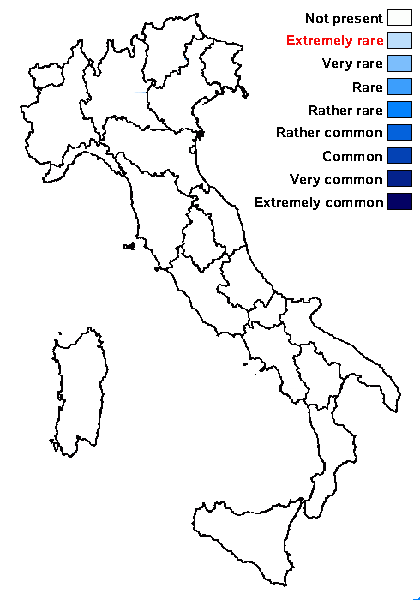Verrucaria zschackei Riedl
Linzer biol. Beitr., 22, 1: 154, 1990
Synonyms:
Distribution:
Description: Thallus crustose, episubstratic or hemiendosubstratic, 25-100 μm thick, continuous to finely rimose around the perithecia, grey, somehow glossy, smooth. Medulla white, sometimes with a 20-40 μm thick, black basal layer. Perithecia black, c. 0.2 mm across, hemispherically projecting, largely covered with a thin thalline layer. Involucrellum usually covered by a thalline layer, reaching to base-level, adpressed to exciple but with spreading flanks, the area between involucrellum and exciple filled by enlarged cells with brown-black walls; exciple 0.12-0.18 μm across; hamathecium of very short, up to 10 μm long periphyses and periphysoids, interascal filaments absent; hymenial gel hemiamyloid, I+ red (I+ blue at very low concentrations of I), K/I+ blue. Asci 8-spored, clavate, I-, fissitunicate, the wall thickened above, with an ocular chamber, dehiscent by extrusion of an endotunica to form a delicate rostrum, Verrucaria-type. Ascospores 1-celled, hyaline, ellipsoid 17-24 x 7-12 μm, not halonate. Photobiont chlorococcoid, the cells not arranged in vertical columns. Spot tests: K-, C-, KC-, P-, UV-. Chemistry: without lichen substances.Note: on calcareous rocks along streams, widespread in Central Europe, with scattered records from the Alps, outside Italian territory. To be looked for in Italy
Growth form: Crustose
Substrata: rocks
Photobiont: green algae other than Trentepohlia
Reproductive strategy: mainly sexual
Periodically submerged (e.g. in creeks)

Predictive model
Growth form: Crustose
Substrata: rocks
Photobiont: green algae other than Trentepohlia
Reproductive strategy: mainly sexual
Periodically submerged (e.g. in creeks)

Predictive model
 INDEX FUNGORUM
INDEX FUNGORUM
 GBIF
GBIF

